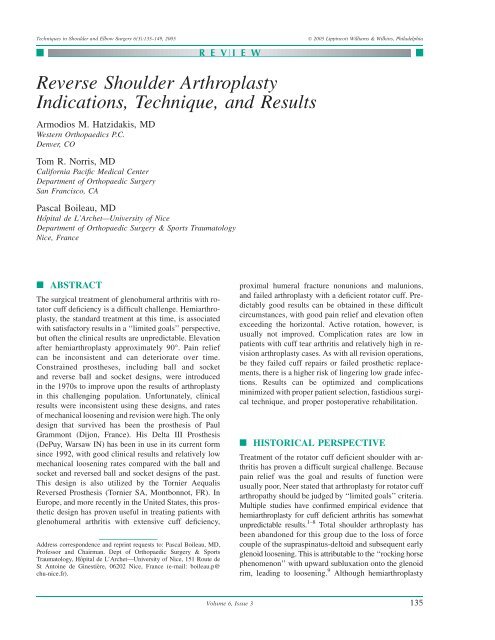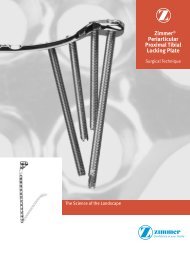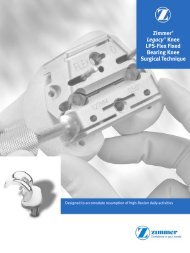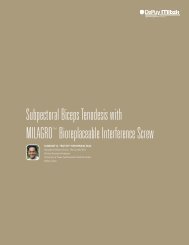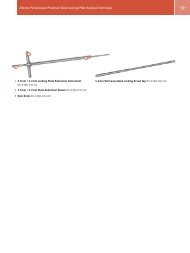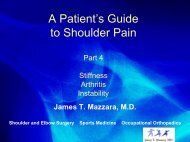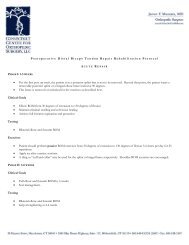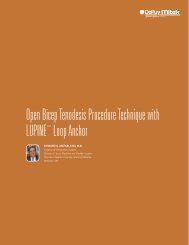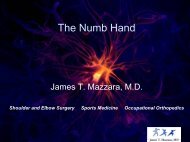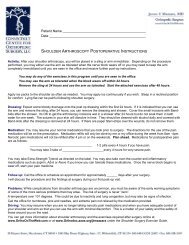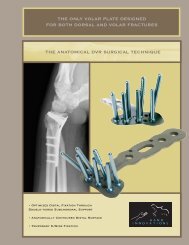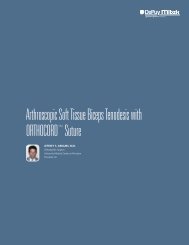Reverse Shoulder Arthroplasty Indications, Technique, and Results
Reverse Shoulder Arthroplasty Indications, Technique, and Results
Reverse Shoulder Arthroplasty Indications, Technique, and Results
You also want an ePaper? Increase the reach of your titles
YUMPU automatically turns print PDFs into web optimized ePapers that Google loves.
<strong>Technique</strong>s in <strong>Shoulder</strong> <strong>and</strong> Elbow Surgery 6(3):135–149, 2005<br />
Ó 2005 Lippincott Williams & Wilkins, Philadelphia<br />
<strong>Reverse</strong> <strong>Shoulder</strong> <strong>Arthroplasty</strong><br />
<strong>Indications</strong>, <strong>Technique</strong>, <strong>and</strong> <strong>Results</strong><br />
Armodios M. Hatzidakis, MD<br />
Western Orthopaedics P.C.<br />
Denver, CO<br />
Tom R. Norris, MD<br />
California Pacific Medical Center<br />
Department of Orthopaedic Surgery<br />
San Francisco, CA<br />
R E V I E W<br />
Pascal Boileau, MD<br />
Hôpital de L’Archet—University of Nice<br />
Department of Orthopaedic Surgery & Sports Traumatology<br />
Nice, France<br />
n ABSTRACT<br />
The surgical treatment of glenohumeral arthritis with rotator<br />
cuff deficiency is a difficult challenge. Hemiarthroplasty,<br />
the st<strong>and</strong>ard treatment at this time, is associated<br />
with satisfactory results in a ‘‘limited goals’’ perspective,<br />
but often the clinical results are unpredictable. Elevation<br />
after hemiarthroplasty approximately 90°. Pain relief<br />
can be inconsistent <strong>and</strong> can deteriorate over time.<br />
Constrained prostheses, including ball <strong>and</strong> socket<br />
<strong>and</strong> reverse ball <strong>and</strong> socket designs, were introduced<br />
in the 1970s to improve upon the results of arthroplasty<br />
in this challenging population. Unfortunately, clinical<br />
results were inconsistent using these designs, <strong>and</strong> rates<br />
of mechanical loosening <strong>and</strong> revision were high. The only<br />
design that survived has been the prosthesis of Paul<br />
Grammont (Dijon, France). His Delta III Prosthesis<br />
(DePuy, Warsaw IN) has been in use in its current form<br />
since 1992, with good clinical results <strong>and</strong> relatively low<br />
mechanical loosening rates compared with the ball <strong>and</strong><br />
socket <strong>and</strong> reversed ball <strong>and</strong> socket designs of the past.<br />
This design is also utilized by the Tornier Aequalis<br />
<strong>Reverse</strong>d Prosthesis (Tornier SA, Montbonnot, FR). In<br />
Europe, <strong>and</strong> more recently in the United States, this prosthetic<br />
design has proven useful in treating patients with<br />
glenohumeral arthritis with extensive cuff deficiency,<br />
Address correspondence <strong>and</strong> reprint requests to: Pascal Boileau, MD,<br />
Professor <strong>and</strong> Chairman. Dept of Orthopaedic Surgery & Sports<br />
Traumatology, Hôpital de L’Archet—University of Nice, 151 Route de<br />
St Antoine de Ginestière, 06202 Nice, France (e-mail: boileau.p@<br />
chu-nice.fr).<br />
proximal humeral fracture nonunions <strong>and</strong> malunions,<br />
<strong>and</strong> failed arthroplasty with a deficient rotator cuff. Predictably<br />
good results can be obtained in these difficult<br />
circumstances, with good pain relief <strong>and</strong> elevation often<br />
exceeding the horizontal. Active rotation, however, is<br />
usually not improved. Complication rates are low in<br />
patients with cuff tear arthritis <strong>and</strong> relatively high in revision<br />
arthroplasty cases. As with all revision operations,<br />
be they failed cuff repairs or failed prosthetic replacements,<br />
there is a higher risk of lingering low grade infections.<br />
<strong>Results</strong> can be optimized <strong>and</strong> complications<br />
minimized with proper patient selection, fastidious surgical<br />
technique, <strong>and</strong> proper postoperative rehabilitation.<br />
n HISTORICAL PERSPECTIVE<br />
Treatment of the rotator cuff deficient shoulder with arthritis<br />
has proven a difficult surgical challenge. Because<br />
pain relief was the goal <strong>and</strong> results of function were<br />
usually poor, Neer stated that arthroplasty for rotator cuff<br />
arthropathy should be judged by ‘‘limited goals’’ criteria.<br />
Multiple studies have confirmed empirical evidence that<br />
hemiarthroplasty for cuff deficient arthritis has somewhat<br />
unpredictable results. 1–8 Total shoulder arthroplasty has<br />
been ab<strong>and</strong>oned for this group due to the loss of force<br />
couple of the supraspinatus-deltoid <strong>and</strong> subsequent early<br />
glenoid loosening. This is attributable to the ‘‘rocking horse<br />
phenomenon’’ with upward subluxation onto the glenoid<br />
rim, leading to loosening. 9 Although hemiarthroplasty<br />
Volume 6, Issue 3<br />
135
Hatzidakis et al<br />
provides a smooth surface for articulation with the native<br />
glenoid <strong>and</strong> acromion, the biomechanical stabilization of<br />
the fulcrum for elevation is still deficient. Sometimes<br />
the intact remaining cuff, deltoid, <strong>and</strong> ‘‘acetabularized’’<br />
acromial arch can compensate for this lack of fulcrum,<br />
but good early results can deteriorate secondary to progressive<br />
erosion of the prosthetic head into the glenoid<br />
<strong>and</strong> acromion (Fig. 1). Pain relief is often good initially,<br />
but can deteriorate over time with glenoid arthritis <strong>and</strong><br />
acromial wear or fracture. The results of hemiarthroplasty<br />
are even more inconsistent in patients who have<br />
a ‘‘pseudoparalytic’’ shoulder, in whom attempts at elevation<br />
are rewarded only with an ineffective shrug. As we<br />
have gained more experience in teasing out subtle causes<br />
of this ineffectual shrug associated with massive rotator<br />
cuff tears, we wish to differentiate between those with<br />
irreparable cuff tears with true pseudo paralysis of the<br />
shoulder (PPS) <strong>and</strong> anterior superior subluxation due<br />
to muscle imbalance, <strong>and</strong> those patients with painful loss<br />
of elevation (PLE) due to an hourglass or otherwise painful<br />
biceps. With PPS humeral head arthroplasty <strong>and</strong><br />
tendon reconstructions have been ineffectual, whereas<br />
with PLE arthroscopic biceps tenotomy has allowed<br />
many to regain overhead elevation.<br />
Multiple constrained <strong>and</strong> semiconstrained prostheses<br />
have been designed to compensate for the loss of rotational<br />
fulcrum caused by severe degeneration of the rotator<br />
cuff. Previous reverse prostheses were designed<br />
by Reeves, Liverpool, Bayley, Neer <strong>and</strong> Averill, Kolbel,<br />
Kessel, Fenlin, <strong>and</strong> Gerard in the 1970s <strong>and</strong> 1980s. Disappointing<br />
results <strong>and</strong> high complication rates led to<br />
ab<strong>and</strong>onment of these prostheses. 10,11 The common denominator<br />
for failure was loosening of the glenoid<br />
component. The center of rotation was lateral to the glenoid<br />
<strong>and</strong> created high torque on the relatively frail<br />
glenoid. The reverse prosthesis (RP) of Professor Paul<br />
Grammont (Dijon, France) was also designed specifically<br />
for the rotator cuff deficient shoulder. 12–14 It differed<br />
from previous prostheses in that the glenoid component<br />
was larger, <strong>and</strong> its center of rotation was medialized<br />
on to the glenoid face, thus decreasing torque on the<br />
component-bone fixation. The humeral neck angle is<br />
nonanatomic <strong>and</strong> made more horizontal. This increases<br />
stability of the new glenohumeral joint. In short to<br />
medium term studies up to 10 years, this prosthesis<br />
has succeeded where others have failed, predominately<br />
because of its favorable biomechanical characteristics.<br />
Short <strong>and</strong> medium-term follow-up studies in Europe have<br />
determined that this specific design leads to functional<br />
restoration of elevation <strong>and</strong> favorable survivorship,<br />
with relatively low rates of early glenoid loosening. 15–22<br />
Two current versions of the prosthesis have been used<br />
in Europe; since 1992 for the Delta <strong>and</strong> since 1998 for<br />
the Tornier. Respectively, these prostheses have been<br />
available in the United States since FDA approval in<br />
November 2003 (DePuy, Warsaw IN) <strong>and</strong> May 2004<br />
(Tornier SA, Montbonnot, FR).<br />
Biomechanics<br />
The RP design of Grammont combines a large hemispherical<br />
glenoid component (36 or 42 mm diameter)<br />
that has a medialized center of rotation <strong>and</strong> secure screw<br />
fixation to the glenoid, with a cemented humeral component<br />
that has a more horizontally aligned (155°) metaphyseal<br />
neck with a reverse hemispherical polyethylene<br />
cup that perfectly conforms to the glenosphere (Fig. 2).<br />
FIGURE 1. A, Humeral head replacement placed for shoulder arthritis with a massive irreconstructible deficiency of the<br />
supraspinatus <strong>and</strong> subscapularis. B, The humeral head ceases to ‘‘roll’’ on the glenoid <strong>and</strong> turns into a ‘‘wedge,’’ leading<br />
to (C) superior erosion of the acromion <strong>and</strong> glenoid. D, The functional result is poor, with forward flexion of approximately<br />
30° <strong>and</strong> persistent pain.<br />
136 <strong>Technique</strong>s in <strong>Shoulder</strong> <strong>and</strong> Elbow Surgery
<strong>Reverse</strong> <strong>Shoulder</strong> <strong>Arthroplasty</strong><br />
This design allows for more range of motion than reverse<br />
ball <strong>and</strong> socket designs of the past (Fig. 3). With proper<br />
placement of this prosthesis, the center of humeral rotation<br />
is made more distal, placing the deltoid muscle at<br />
greater tension (Fig. 4), <strong>and</strong> medialized, which recruits<br />
more deltoid muscle fibers for elevation <strong>and</strong> increases<br />
the deltoid lever arm. 3 These factors increase the deltoid’s<br />
biomechanical ability to generate rotational torque,<br />
elevating the arm on a new stable fulcrum (the glenosphere).<br />
The medialized center of rotation decreases<br />
torsional forces on glenosphere fixation, decreasing the<br />
tendency of the glenoid component to loosen (Fig. 5).<br />
FIGURE 2. The <strong>Reverse</strong>d <strong>Shoulder</strong> ProsthesisÔ (Tornier<br />
Inc., Tornier SA, Montbonnot, FR).<br />
n INDICATIONS/<br />
CONTRAINDICATIONS<br />
There are 3 specific circumstances where we have found<br />
the RP to be useful. The common characteristic of these<br />
indications is that the biomechanical fulcrum for elevation<br />
is lost, either via irreparable loss of the rotator cuff<br />
or severe malposition of the tuberosities.<br />
The first indication is primary osteoarthritis of the<br />
shoulder with massive irreparable cuff tear, in patients<br />
with secondary osteoarthritis or osteonecrosis who have<br />
a ‘‘decompensated’’ cuff deficiency (‘‘Cuff Tear Arthritis,’’<br />
CTA). These patients typically suffer from significant<br />
pain <strong>and</strong> cannot lift their arms to the horizontal<br />
despite attempts to strengthen the deltoid <strong>and</strong> remaining<br />
intact cuff. Many of these patients have had one or many<br />
attempts to repair the rotator cuff, <strong>and</strong> some may exhibit<br />
FIGURE 3. A reversed design of the<br />
past utilizes a small prosthetic head with<br />
highly constrained humeral cup, leading<br />
to decreased potential range of motion<br />
compared with the Grammont design.<br />
Volume 6, Issue 3<br />
137
Hatzidakis et al<br />
FIGURE 4. A, Deltoid elevation torque<br />
in the cuff deficient shoulder is decreased<br />
secondary to proximal humeral<br />
migration, whereas elevation torque in<br />
the Grammont reverse shoulder (B) is<br />
increased because of a medialized<br />
<strong>and</strong> lowered center of rotation (L2 3<br />
F2 . L1 3 F1).<br />
marked anterosuperior escape of the humeral head with<br />
attempted elevation. Patients with anterosuperior escape<br />
are usually not helped by humeral hemiarthroplasty, even<br />
with attempted coracoacromial arch reconstruction,<br />
making them ideal c<strong>and</strong>idates for reversed shoulder<br />
arthroplasty.<br />
The second indication is severe fracture sequelae<br />
(FS). These patients have had a displaced, usually comminuted<br />
fracture of the proximal humerus with tuberosity<br />
malposition or nonunion. Although an unconstrained<br />
prosthesis can reliably provide pain relief <strong>and</strong> restore<br />
function in those cases where the prosthesis can be<br />
‘‘adapted’’ to slight tuberosity malalignment, patients<br />
who have unhealed tuberosities or require osteotomy of<br />
the greater tuberosity do not typically fare as well. 23 An<br />
RP can consistently provide both pain relief <strong>and</strong> restoration<br />
of active elevation in this specific patient group.<br />
The third indication for reverse shoulder arthroplasty<br />
is revision of previously failed arthroplasty. Typically<br />
these patients have had a hemiarthroplasty placed for<br />
CTA or comminuted proximal humerus fracture. In<br />
CTA cases, common causes for failure are loss of the<br />
FIGURE 5. A, The lateralized center of<br />
rotation <strong>and</strong> constrained design of previous<br />
reverse designs leads to more<br />
shear forces on glenoid fixation compared<br />
with the less constrained, medialized<br />
center of rotation of the Grammont<br />
design (B).<br />
138 <strong>Technique</strong>s in <strong>Shoulder</strong> <strong>and</strong> Elbow Surgery
<strong>Reverse</strong> <strong>Shoulder</strong> <strong>Arthroplasty</strong><br />
fulcrum for elevation (dysfunctional cuff or postoperative<br />
subscapularis rupture with resulting instability)<br />
<strong>and</strong> progressive erosion into the glenoid <strong>and</strong>/or acromion.<br />
This leads to increased pain <strong>and</strong> decreased function.<br />
Common causes for failure in fracture cases are<br />
malposition of the component <strong>and</strong> tuberosity malunion<br />
or nonunion. In CTA <strong>and</strong> post-fracture cases, revision<br />
hemiarthroplasty or conversion to total shoulder arthroplasty<br />
with soft tissue <strong>and</strong>/or bony procedures is either<br />
unpredictable or contraindicated. At times, even with apparent<br />
cuff restoration, the scarring <strong>and</strong> multiple operations<br />
result in the cuff not functioning effectively. Motion<br />
<strong>and</strong> function are lost despite heroic efforts with surgery<br />
<strong>and</strong> rehabilitation. In our experience, RP placement in<br />
these cases is less beneficial than in primary CTA<br />
patients, but the results seem to be more satisfactory than<br />
with other procedures that have been described. With the<br />
revision prosthesis cases, particularly those with multiple<br />
previous operations, low grade infections are more common.<br />
All precautions are observed to anticipate, diagnose,<br />
<strong>and</strong> treat any potential sepsis.<br />
Relative <strong>Indications</strong><br />
Acute fractures <strong>and</strong> old nonunions in the very elderly<br />
where rotator cuff rehabilitation is suboptimal is an example<br />
where early results are reported to be good, but longer<br />
follow-up is lacking. Early European (D. Mole) <strong>and</strong><br />
U.S. experience with the RP have been encouraging for<br />
the very elderly patient with acute proximal humeral<br />
4-part fractures. Using the prosthesis in these patients<br />
can be beneficial, as the need for tuberosity union is<br />
bypassed <strong>and</strong> post operative rehabilitation is expedited.<br />
Contraindications<br />
This prosthesis should not be used in primary osteoarthritis<br />
or osteonecrosis of the shoulder when the articular<br />
surface–tuberosity relationships are normal <strong>and</strong> the rotator<br />
cuff is intact <strong>and</strong> functional. These patients are best<br />
served with a third generation anatomic unconstrained<br />
total shoulder arthroplasty. The RP also should not be<br />
used if the patient exhibits marked deltoid deficiency,<br />
as the shoulder will not function well <strong>and</strong> will be prone<br />
to dislocate. A history of previous infection is a relative<br />
contraindication, as recurrence in these patients is high.<br />
Finally, the RP should be used only sparingly in patients<br />
less than 65 years old, as long-term survivorship <strong>and</strong><br />
complication rates are unknown.<br />
<strong>Reverse</strong>d <strong>Shoulder</strong> ProsthesisÔ is available through<br />
Tornier SA, (Montbonnot, FR). For practical purposes<br />
of this technique description, the Aequalis <strong>Reverse</strong>d<br />
<strong>Shoulder</strong> Prosthesis will be referenced, although the<br />
steps are somewhat similar for the Delta III. The glenoid<br />
component consists of a circular baseplate (metaglene),<br />
which is fixed to the native glenoid with 2 compression<br />
screws <strong>and</strong> 2 locked screws (Fig. 6). In the United States,<br />
the surface of the plate that contacts the glenoid bone is<br />
grit blasted <strong>and</strong> roughened to aid with ongrowth. The superior<br />
<strong>and</strong> inferior holes in the baseplate are threaded<br />
<strong>and</strong> angled 20° superiorly <strong>and</strong> inferiorly, respectively.<br />
The anterior <strong>and</strong> posterior screw holes are not threaded,<br />
leaving flexibility to place the anterior <strong>and</strong> posterior<br />
compression screws into the best bone that is available.<br />
The articulating glenoid component, or glenosphere, is<br />
a smooth cobalt-chrome hemisphere that is fixed to the<br />
baseplate via a Morse taper <strong>and</strong> countersunk set screw<br />
(Fig. 7), placing the center of rotation at the level of<br />
the glenoid/baseplate interface.<br />
The humeral component is designed for cemented<br />
use only, with a cup shaped metaphyseal component that<br />
is fixed to stems of variable lengths via a screw-on mechanism.<br />
The metaphyseal cut–shaft angle is 155°. This<br />
horizontal inclination leads to stability of the metaphyseal<br />
polyethylene cup when articulating with the glenosphere.<br />
In the Aequalis <strong>Reverse</strong>d <strong>Shoulder</strong>Ô system,<br />
polyethylene inserts of increasing diameter (6 mm,<br />
9 mm, <strong>and</strong> 12 mm) (Fig. 8) are available, in addition<br />
to a metal metaphyseal offset extension (9 mm). With<br />
the metaphyseal extension, 15 mm, 18 mm, <strong>and</strong> 21 mm<br />
offsets become available. Availability of these different<br />
polyethylene thicknesses <strong>and</strong> offset lengths are particularly<br />
useful in the revision situation, when bone loss<br />
makes prosthetic tension more difficult to set precisely<br />
via cementation of the humeral component. At the time<br />
of this writing, the Delta III prosthesis (DePuy, Warsaw<br />
IN) has a 6 mm <strong>and</strong> 9 mm insert, the 9 mm metal extension,<br />
<strong>and</strong> a deeper ‘‘retentive’’ cup option (6 mm) with<br />
a deeper thinner polyethylene insert.<br />
n COMPONENTS AND<br />
MANUFACTURERS<br />
Currently the RP design of Grammont is offered by two<br />
prosthetic manufacturers. The Delta IIIÔ prosthesis is<br />
available through DePuy (Warsaw IN), <strong>and</strong> the Aequalis<br />
FIGURE 6. The baseplate is attached to the native glenoid<br />
by a press-fit central peg, 2 compression screws (anterior<br />
<strong>and</strong> posterior), <strong>and</strong> 2 locking screws (superior <strong>and</strong> inferior).<br />
Volume 6, Issue 3<br />
139
Hatzidakis et al<br />
wear of the glenoid, giving the surgeon an idea of how<br />
much reaming is required inferiorly to create ideal glenosphere<br />
inferior tilt (0–15°). In cases of very severe superior<br />
glenoid erosion, an iliac crest bone graft can be<br />
planned to fill the bony deficiency. In special circumstances,<br />
the humeral head may also be harvested after<br />
removing any remaining articular cartilage <strong>and</strong> then used<br />
to bone graft the glenoid defect with or without supplemental<br />
iliac crest graft (Fig. 9).<br />
FIGURE 7. The glenosphere is fixed securely to the baseplate<br />
via a Morse taper <strong>and</strong> countersunk set screw.<br />
n PREOPERATIVE PLANNING<br />
Preoperative radiographs include a true AP of the shoulder<br />
with the arm in neutral rotation (Grashey view), an<br />
axillary lateral view, <strong>and</strong> a scapular lateral view. We typically<br />
obtain a long AP of the humeral shaft with the AP<br />
shoulder view to ensure that the humeral canal is normal<br />
<strong>and</strong> a cemented humeral component can be inserted without<br />
complication. In addition, a Computerized Tomography<br />
scan is obtained of the shoulder, including the entire<br />
scapula with 2 mm cuts, so that fatty atrophy of the cuff 25<br />
12 can be examined <strong>and</strong> accurate 2-dimensional coronal<br />
reconstructions can be obtained. The axial cuts give the<br />
surgeon an estimate of glenoid size <strong>and</strong> the feasibility of<br />
glenoid implantation, as the glenoid can occasionally be<br />
asymmetrically worn. The axial cuts also are good indicators<br />
of the degree of fatty infiltration that has occurred<br />
in the posterior cuff, an important prognostic indicator<br />
for regaining some functional external rotation 16 . The<br />
coronal reconstructions show the amount of superior<br />
FIGURE 8. The <strong>Reverse</strong>d <strong>Shoulder</strong> ProsthesisÔ (Tornier<br />
Inc., Tornier SA, Montbonnot, FR) has 3 humeral polyethylene<br />
inserts of different thicknesses, in addition to a 9 mm<br />
metal extension (not pictured), to optimize deltoid tension<br />
<strong>and</strong> prosthetic stability.<br />
n TECHNIQUE<br />
For the purposes of this paper, our technique for implantation<br />
will be described for the ‘‘virgin’’ CTA case.<br />
Although Grammont initially described a transacromial<br />
approach for placement of this prosthesis, most<br />
surgeons now use a deltopectoral or anterosuperior approach.<br />
We prefer the deltopectoral approach, as it spares<br />
the deltoid insertion <strong>and</strong> axillary nerve <strong>and</strong> is highly useful<br />
in prosthetic revision surgery.<br />
Exposure <strong>and</strong> Humeral Preparation<br />
The deltopectoral approach is st<strong>and</strong>ard, with an incision<br />
started just superior <strong>and</strong> medial to the coracoid process<br />
<strong>and</strong> extended obliquely distally to the deltoid insertion<br />
at the mid-arm. The subcutaneous tissues are dissected<br />
with knife <strong>and</strong> electrocautery. The cephalic vein is retracted<br />
laterally with the deltoid <strong>and</strong> the deltopectoral<br />
interval fully dissected from the clavicle to the insertion<br />
of the pectoralis major on the proximal humerus. The<br />
proximal humerus has typically migrated superiorly.<br />
The coracoacromial ligament is visualized, followed<br />
by removal of the subscapularis bursa <strong>and</strong> identification<br />
of the conjoint tendon. The deltoid is retracted laterally<br />
using a broad Richardson retractor, <strong>and</strong> the conjoint tendon<br />
gently retracted medially using a narrow blunt<br />
Richardson retractor. The remaining subscapularis is<br />
tagged with medially placed #5 braided suture, <strong>and</strong> the<br />
subscapularis is tenotomized 1 cm from its insertion. Release<br />
of the subscapularis continues inferiorly, releasing<br />
the inferior muscular fibers <strong>and</strong> inferior capsule from the<br />
humerus while an assistant provides gentle progressive<br />
external rotation to the arm. The superior 1 cm of the<br />
pectoralis insertion is also occasionally released to assist<br />
in ease of exposure.<br />
Superiorly, the cuff is usually absent. In cases of previous<br />
failed cuff repair, suture <strong>and</strong> scar are removed, <strong>and</strong><br />
the interval between the cuff <strong>and</strong> acromion dissected<br />
sharply or with electrocautery. The posterior cuff <strong>and</strong> tuberosity<br />
is freed from the overlying deltoid sharply or<br />
with electrocautery, taking care not to injure the axillary<br />
nerve inferiorly.<br />
At this point the humerus is readily dislocated anteriorly<br />
<strong>and</strong> superiorly for humeral preparation. The<br />
140 <strong>Technique</strong>s in <strong>Shoulder</strong> <strong>and</strong> Elbow Surgery
<strong>Reverse</strong> <strong>Shoulder</strong> <strong>Arthroplasty</strong><br />
FIGURE 9. One potential solution for glenoid bone loss (TRN): Rheumatoid arthritis <strong>and</strong> Arthrokatadysis of the upper glenoid.<br />
The defect in the glenoid was bone grafted with the osteotomized humeral head (HH) as it fit the erosion perfectly (A).<br />
The HH had to be osteotomized more vertically than usual for the st<strong>and</strong>ard approach for the <strong>Reverse</strong>, then temporarily fixed<br />
with Steinmann pins <strong>and</strong> then fixed with the baseplate (B). Ideally the post of the baseplate reaches the native scapula.<br />
highest, most lateral point on the humeral head is identified<br />
as a reference point. A hole is created with an awl;<br />
the head cutting guide is inserted into the humeral shaft<br />
via this hole, <strong>and</strong> retroversion is determined using a pin<br />
set at the desired degree. Grammont advocated a version<br />
of 0°. We typically set the cut between 0 <strong>and</strong> 20° of retroversion,<br />
as this version seems to allow ‘‘filling’’ of the<br />
metaphysis without anterior cortical protrusion, <strong>and</strong> may<br />
allow for slightly improved functional external rotation.<br />
Nonetheless, the optimal retroversion for this component<br />
has yet to be defined. A minimal head cut is made parallel<br />
to the undersurface of the neck cutting guide, taking<br />
care not to hit the shaft of the cutting guide with the saw<br />
(Fig. 10). The guide is removed <strong>and</strong> the cut completed<br />
with either the saw or an osteotome. Cancellous bone<br />
is harvested from the remaining humeral head <strong>and</strong> saved<br />
to graft the glenoid central hole prior to inserting the<br />
baseplate. Then the metaphyseal ‘‘cheese grater’’ reamer<br />
is used to remove remaining cancellous bone from the<br />
proximal humerus to allow metaphyseal component<br />
placement (Fig. 11). There are 2 sizes of reamers, 36<br />
<strong>and</strong> 42 mm. The size that fits best is usually 36 mm,<br />
FIGURE 10. The humeral cutting guide<br />
<strong>and</strong> version rod (A). The version rod is<br />
aligned with the forearm to determine<br />
the version of the humeral head cut (B).<br />
Volume 6, Issue 3<br />
141
Hatzidakis et al<br />
but for larger individuals or those with previous prosthetic<br />
instability, preparation for a 42 mm component may be<br />
preferred. The decision on reamer size is based on preoperative<br />
planning <strong>and</strong> intraoperative estimation of humeral<br />
<strong>and</strong> glenoid size.<br />
Distal metaphyseal reaming is then performed with<br />
a long conical reamer, inserting the reamer so that the<br />
height l<strong>and</strong>mark is level with the highest part of the humeral<br />
cut. Diaphyseal reaming is then performed sequentially<br />
with reamers of 6.5, 9, 12, <strong>and</strong> 15 mm until the<br />
reamer comes into contact with diaphyseal cortical bone.<br />
If the reamer of a specific size reaches the appropriate<br />
depth as noted by the height l<strong>and</strong>mark with chatter,<br />
reaming is stopped. Preparing the canal more aggressively<br />
risks fracturing the humerus as well as not having an adequate<br />
cement mantle.<br />
The humeral trial is then assembled <strong>and</strong> retroversion<br />
rod set to 0 to 20°, according to the preference of the<br />
surgeon. The trial is then inserted with manual pressure,<br />
followed by light impaction with a mallet. A plastic<br />
cut protector is then placed into the metaphysis of the<br />
component to protect the trial component during glenoid<br />
preparation. At times the medial head still protrudes<br />
<strong>and</strong> needs trimming to facilitate retraction <strong>and</strong> glenoid<br />
exposure.<br />
Glenoid Preparation<br />
Homan <strong>and</strong> Kolbel retractors are used to retract the soft<br />
tissues <strong>and</strong> proximal humerus while a circumferential<br />
capsulotomy <strong>and</strong> labral excision are performed. The<br />
FIGURE 11. A cup is made in the native proximal humerus<br />
using the power ‘‘cheese grater’’ reamer to accept the humeral<br />
metaphyseal component.<br />
origin of the long head of the triceps is released from<br />
the inferior glenoid, <strong>and</strong> the lateral pillar of the scapula<br />
is palpated. A 2-prong Tiemannn Capsular retractor is<br />
placed against the lateral pillar/scapular neck. This serves<br />
as a reference guide later for the superior-inferior orientation<br />
of the baseplate, so that the inferior screw be<br />
placed down the center of the axial border of the scapula.<br />
Glenoid osteophytes are removed to reveal the true glenoid<br />
anatomic shape <strong>and</strong> more correctly identify the base<br />
of glenoid bone that is most solid for baseplate (metaglene)<br />
placement. The central hole guide is assembled<br />
<strong>and</strong> placed with the h<strong>and</strong>le inferior for the deltopectoral<br />
approach. The inferior most edge of the guide is placed<br />
against the inferior most edge of the glenoid. This ensures<br />
that the metaglene is placed against the glenoid<br />
as inferior as possible. Alternatively, one may prefer to<br />
invert the baseplate <strong>and</strong> use it as a guide to ensure more<br />
inferior placement. The goal is to have the glenosphere<br />
inferior enough <strong>and</strong> tilted inferiorly a few degrees to decrease<br />
any contact of the polyethylene insert with the<br />
scapula. This nuance is the recent attempt to prevent<br />
scapular notching. Based on preoperative CT scanning<br />
the guide is angled inferiorly to create an inferior tilt<br />
to the reamed surface of 0–15°. The central hole is then<br />
drilled with a 6 mm bit, which has a self-stop (Fig. 12).<br />
The guide is then removed, followed by placing the flat<br />
glenoid reamer (Fig. 12). The reamer is started away<br />
from the bone, then pushed slowly into the glenoid to<br />
gently flatten the glenoid face, conservatively removing<br />
bone to preserve as much of the subchondral plate as possible.<br />
Once a uniformly flat surface has been created<br />
<strong>and</strong> a 1–2 mm groove is created circumferentially, the<br />
reaming is complete. The groove must be created to<br />
allow placement of the baseplate flush against the bone.<br />
The reamer is removed <strong>and</strong> the glenoid central hole drill<br />
guide placed, followed by over-drilling of the central hole<br />
with a 7.5 mm drill with a self-stop (Fig. 13). The cancellous<br />
bone graft is impacted in the post hole. The baseplate<br />
inserter is assembled <strong>and</strong> the 8.0 mm baseplate<br />
central post is impacted into the 7.5 mm drilled hole for<br />
a press-fit into the scapula.<br />
There is an ‘‘up’’ <strong>and</strong> ‘‘down’’ marker on the inserter<br />
with a vertical line that allows orientation of the baseplate<br />
so that the inferior drill hole is aligned with the inferior<br />
pillar of the scapular neck (Fig. 14). This ensures<br />
placement of an inferior screw that is as long as possible.<br />
The baseplate is impacted against the glenoid bone with<br />
several sharp blows with a mallet. The inserter is gently<br />
removed, leaving the baseplate in place. The positioning<br />
of the superior <strong>and</strong> inferior locking screws is most critical.<br />
We prefer to place the inferior screw first to set the<br />
rotation of the baseplate. The threaded drill guide is<br />
screwed into the metaglene screw hole. A long 3 mm drill<br />
bit is inserted into the guide, drilling through the face of<br />
142 <strong>Technique</strong>s in <strong>Shoulder</strong> <strong>and</strong> Elbow Surgery
<strong>Reverse</strong> <strong>Shoulder</strong> <strong>Arthroplasty</strong><br />
FIGURE 12. A center hole is drilled for<br />
reaming using the appropriate guide<br />
(A), followed by reaming the glenoid flat<br />
(B), preferably with a 10° downward tilt.<br />
the glenoid <strong>and</strong> along the inferior pillar of the scapula<br />
(Fig. 15). After the far cortex is breached, the length is<br />
measured <strong>and</strong> the inferior screw placed. It is fully advanced<br />
temporarily, ‘‘locked’’ into the baseplate, keeping<br />
it from rotating during subsequent screw placement. The<br />
superior screw is then drilled, measured, <strong>and</strong> inserted.<br />
The anterior <strong>and</strong> posterior screws are then drilled <strong>and</strong><br />
proper lengths measured (Fig. 16). These 2 screws are<br />
then inserted but not tightened until the superior <strong>and</strong><br />
inferior screws are temporarily loosened, unlocking them<br />
from the baseplate. The anterior <strong>and</strong> posterior screws are<br />
then tightened sequentially to achieve compression of the<br />
baseplate against the prepared glenoid surface. Once full<br />
compression is obtained with the anterior <strong>and</strong> posterior<br />
screws, the superior <strong>and</strong> inferior screws are locked to<br />
achieve final baseplate fixation. The baseplate should<br />
be very well fixed to the bone. This requires at least<br />
3 of the 4 screws having good purchase.<br />
The glenosphere of choice (36 or 42 mm) is then<br />
guided to the metaglene using a screwdriver (Fig. 17).<br />
The glenosphere is gently pressed onto the Morse taper<br />
of the metaglene <strong>and</strong> the screwdriver is removed. The<br />
glenosphere is firmly seated onto the Morse taper of the<br />
metaglene using a polyethylene impactor <strong>and</strong> several<br />
sharp blows of the mallet. Final glenosphere fixation is<br />
secured by tightening the center set screw, which threads<br />
into a mating thread on the inside of the center peg of<br />
the metaglene (Fig. 17). Care is taken throughout these<br />
steps to ensure that soft tissue is completely cleared<br />
from the periphery of the glenoid so that incomplete<br />
glenosphere-metaglene fixation <strong>and</strong> postoperative lucent<br />
lines do not occur.<br />
FIGURE 13. The center hole is widened<br />
slightly by the 7.5 mm drill bit <strong>and</strong> guide<br />
so it will accept the 8 mm diameter<br />
central peg of the baseplate with a good<br />
press-fit.<br />
Volume 6, Issue 3<br />
143
Hatzidakis et al<br />
FIGURE 14. The glenoid baseplate (in<br />
this case coated with hydroxyapatite)<br />
is impacted onto the glenoid, with the<br />
lower mark aligned with the lateral pillar<br />
of the scapula.<br />
Glenohumeral Trialing, Humeral Component<br />
Implantation, <strong>and</strong> Final Reduction<br />
After the glenosphere is firmly implanted, the humerus<br />
can be redislocated out of the incision. Care is taken<br />
not to scratch the glenosphere during the dislocation<br />
maneuver. A 6 mm trial humeral insert is then placed<br />
<strong>and</strong> impacted into the humeral trial metaphyseal cup<br />
(Fig. 18). A trial reduction is performed. The humeral<br />
component should rotate nicely without signs of instability.<br />
Gentle traction is applied to the arm to perform a<br />
‘‘shuck’’ maneuver. There should be less than 1 mm of<br />
diastasis between the humeral cup <strong>and</strong> glenosphere during<br />
this maneuver to ensure proper stability. If the shoulder<br />
cannot be reduced with a 6 mm insert, then the trial<br />
is removed, adhesions lysed, <strong>and</strong> additional proximal<br />
humeral bone resected if necessary.<br />
Once it is determined that the shoulder will reduce,<br />
the proximal humeral component is cemented. A<br />
cement restrictor is inserted <strong>and</strong> the humeral shaft<br />
meticulously dried. Cementing technique is very important<br />
for this prosthesis, as there may be more problems<br />
with humeral loosening with the <strong>Reverse</strong> Prosthesis than<br />
with unconstrained total shoulder replacement. Press fit<br />
placement of the humeral component is not recommended<br />
at this time following some earlier experience<br />
with subsidence.<br />
FIGURE 15. Correct position of the<br />
baseplate is confirmed by first drilling<br />
the inferior locking screw hole with a long<br />
guide that threads into the plate.<br />
144 <strong>Technique</strong>s in <strong>Shoulder</strong> <strong>and</strong> Elbow Surgery
<strong>Reverse</strong> <strong>Shoulder</strong> <strong>Arthroplasty</strong><br />
FIGURE 16. With the superior <strong>and</strong> inferior<br />
locking screws partially advanced<br />
(not locked into the plate), the anterior<br />
<strong>and</strong> posterior screws are drilled <strong>and</strong><br />
filled with 4.5 mm screws, compressing<br />
the baseplate to the glenoid bone. The<br />
superior <strong>and</strong> inferior screws are then advanced,<br />
‘‘locking’’ the fixation construct.<br />
After the humeral component is well fixed with cement,<br />
the 6 mm trial insert is placed into the metaphysis<br />
<strong>and</strong> the shoulder reduced. If the tension is adequate, the<br />
shoulder is redislocated <strong>and</strong> the final polyethylene liner<br />
impacted into the metaphyseal cup (Fig. 19). If there is<br />
insufficient tension, gradually increasing sizes of liner<br />
trials are used to obtain the optimum fit. In the primary<br />
CTA case it is rare that a liner over 9 mm is required, but<br />
the larger 12 mm liner <strong>and</strong> 9 mm metaphyseal extension<br />
are often essential for the revision situation.<br />
After the shoulder is reduced with final implants in<br />
position, the subscapularis is repaired via 3 to 4 tendon<br />
to tendon sutures, occasionally augmenting the repair<br />
with transosseous sutures if the remaining tendon tag<br />
on the humerus is insufficient. The deltopectoral interval<br />
is closed over a drain, with a running absorbable suture.<br />
The skin is closed in routine fashion. Postoperative radiographs<br />
are obtained in the recovery room (Fig. 20).<br />
n POSTOPERATIVE MANAGEMENT<br />
The shoulder is immobilized in slight abduction <strong>and</strong> in<br />
near-neutral rotation. Gentle passive motion in all planes<br />
is started immediately, taking care not to push the limit of<br />
intraoperative motion measurements. Active assisted<br />
motion is started at 3 to 4 weeks postoperatively, followed<br />
by active motion at approximately 6 weeks<br />
postoperative. The immobilizer is discontinued at this<br />
FIGURE 17. The glenosphere is lightly<br />
advanced onto the reverse Morse taper<br />
of the baseplate using the center screwdriver.<br />
The screwdriver is then removed<br />
<strong>and</strong> a polyethylene impactor applied to<br />
the glenosphere, followed by several<br />
sharp blows with the mallet to seat the<br />
prosthesis. The center screwdriver is<br />
then used again, this time to advance<br />
the recessed central screw firmly into<br />
the peg of the baseplate.<br />
Volume 6, Issue 3<br />
145
Hatzidakis et al<br />
n RESULTS<br />
We recently performed a retrospective review of 45 reverse<br />
shoulder arthroplasty patients, with an average follow<br />
up of 42 months. 16 The indication for the procedure<br />
was end-stage glenohumeral arthritis with massive irreparable<br />
rotator cuff tear in 21 patients, revision of failed<br />
hemiarthroplasty in 19 patients, <strong>and</strong> fracture sequelae<br />
with severe malunion or nonunion of the tuberosities in<br />
5 patients. All 3 groups showed a significant increase<br />
in active elevation (from 55° pre-operatively to 121° postoperatively)<br />
<strong>and</strong> Constant Score 24 (from 17 to 59), but<br />
no significant change in active external rotation (from<br />
7° to 11°) or internal rotation (S1 pre <strong>and</strong> postoperatively).<br />
Seventy-eight percent of patients were satisfied or very<br />
satisfied with the result, <strong>and</strong> 67% of patients had no or<br />
slight pain. However, the postoperative Constant Score,<br />
adjusted Constant Score, <strong>and</strong> ASES <strong>Shoulder</strong> Score were<br />
all significantly higher in the CTA group as compared<br />
with the revision group (P = 0.01, 0.004, <strong>and</strong> 0.002,<br />
respectively). Severe fatty infiltration of the teres minor 25<br />
was associated with lower external rotation (0° vs. 15°,<br />
P = 0.02) <strong>and</strong> lower functional results (Constant score:<br />
46 vs. 66, P = 0.007).<br />
FIGURE 18. The trial insert is impacted into the trial humeral<br />
prosthesis, followed by a reduction to assess tension<br />
<strong>and</strong> stability.<br />
time. Activities as tolerated are allowed at 3 to 4 months<br />
postoperatively.<br />
Complications<br />
In our series of 45 patients, 14 complications occurred<br />
in 11 patients (24%). The most common complications<br />
were dislocation (3 cases), deep infection (3 cases), periprosthetic<br />
humeral fracture (2 cases), <strong>and</strong> late acromial<br />
fracture (2 cases). One case of postoperative hematoma,<br />
axillary nerve palsy, <strong>and</strong> symptomatic humeral loosening<br />
were also observed. Complication <strong>and</strong> revision rates<br />
were highest in the revision group (47% <strong>and</strong> 26%,<br />
respectively).<br />
Ten patients (22%) needed further surgery for treatment<br />
of a complication. All 3 dislocation patients (1 in<br />
the CTA group, 2 in the revision group) were brought<br />
back to the operating room for liner exchange or addition<br />
of the 9 mm metal spacer with retentive 6 mm liner. Two<br />
FIGURE 19. The final polyethylene<br />
insert is impacted into the humeral<br />
prosthesis.<br />
146 <strong>Technique</strong>s in <strong>Shoulder</strong> <strong>and</strong> Elbow Surgery
<strong>Reverse</strong> <strong>Shoulder</strong> <strong>Arthroplasty</strong><br />
FIGURE 20. Final radiographs. Note<br />
the slight inferior tilt of the glenosphere.<br />
patients in the revision group required prosthetic removal<br />
for infection. One infection in the revision group was<br />
treated successfully with 1-stage irrigation, debridement,<br />
<strong>and</strong> polyethylene liner exchange. One patient in the revision<br />
group developed aseptic humeral loosening. The<br />
humeral component was revised 1 year postoperatively.<br />
Another patient required revision for treatment of a periprosthetic<br />
humeral fracture sustained in a motor vehicle<br />
accident. Although no cases of glenoid loosening were<br />
observed, 1 patient required removal of the glenosphere<br />
on postoperative day number 1. The glenoid was fractured<br />
during reaming, but the metaglene <strong>and</strong> glenosphere<br />
appeared to be stable after implantation. The glenosphere<br />
was noted to lose fixation on postoperative radiographs,<br />
<strong>and</strong> the patient was brought back to the operating room<br />
for conversion to a humeral head replacement.<br />
Scapular notching, or loss of inferior glenoid bone<br />
secondary to impingement of the prosthesis against the<br />
inferior glenoid neck (Fig. 21), was observed on final<br />
radiographs in 24 cases (74%). Twenty-eight percent<br />
of patients exhibited scapular notching that extended<br />
beyond the inferior screw. Despite the high percentage<br />
of cases that exhibited scapular notching, none were<br />
symptomatic <strong>and</strong> no cases of glenoid loosening were noted.<br />
Heterotopic ossification was noted on postoperative<br />
radiographs in 17 cases (45%), always occurring at the<br />
lower margin of the glenoid. Grade I ossification 18<br />
was found in 11 cases, grade 2 in 2 cases, <strong>and</strong> grade<br />
III in 4 cases 26 . Grade III ossification cases tended to<br />
have greater restriction in range of motion (passive <strong>and</strong><br />
active) than patients with less severe heterotopic ossification.<br />
A bony spur at the inferior margin of the scapular<br />
neck was noted in 24 cases (63%) <strong>and</strong> was always associated<br />
with a scapular notch (Fig. 21).<br />
n FUTURE OF THE TECHNIQUE<br />
Our most pressing concern regarding this prosthesis is<br />
that it is used for the correct indications, as outlined above.<br />
The Tornier Aequalis <strong>Reverse</strong>d <strong>Shoulder</strong> ProsthesisÔ<br />
was designed based upon the principles of Paul Grammont,<br />
including a horizontal humeral neck cut, hemispherical<br />
glenoid component with secure locked screw fixation,<br />
<strong>and</strong> a medialized <strong>and</strong> lowered center of rotation<br />
that increases the effectiveness of the deltoid while minimizing<br />
glenoid loosening. The prosthesis is designed<br />
for individuals with end-stage glenohumeral arthritis<br />
with an extensive irreparable cuff deficiency. Although<br />
short <strong>and</strong> intermediate term data regarding the longevity<br />
of this prosthesis are quite favorable, long term data are<br />
FIGURE 21. ‘‘Notching’’ of the inferior glenoid by the<br />
medial humeral prosthetic neck. Note the hypertrophic<br />
osteophyte just medial to the notch.<br />
Volume 6, Issue 3<br />
147
Hatzidakis et al<br />
FIGURE 22. A, Anteroposterior radiograph of glenohumeral arthritis with extensive cuff deficiency in a patient with a ‘‘pseudoparalytic’’<br />
painful shoulder. Axial computerized tomography slice reveals rupture of the subscapularis <strong>and</strong> significant atrophy<br />
of the external rotators. B, Anteroposterior radiograph of the shoulder at maximum elevation. Postoperative radiograph<br />
of the patient’s reverse prosthesis, <strong>and</strong> her forward flexion 9 months postoperatively.<br />
not available. Therefore, at this time we favor restricting<br />
the use of this prosthesis to older individuals. The major<br />
benefit of this prosthesis is that shoulder level function<br />
<strong>and</strong> above can reliably be achieved in patients with uncomplicated<br />
rotator cuff deficient arthritis (Fig. 22). This<br />
consistency of results has not been achieved in our or<br />
others’ h<strong>and</strong>s with the use of conventional hemiarthroplasty.<br />
Although the prosthesis offers some hope of pain<br />
relief <strong>and</strong> restoration of function in patients who require<br />
revision of failed shoulder prosthesis, complication rates<br />
are high (approximately 50%). Dislocation rates may be<br />
decreased by the availability of multiple length options<br />
for the humeral polyethylene insert <strong>and</strong> with use of the<br />
larger component. We anticipate that this prosthetic design<br />
will continue to be a valuable tool in treating patients<br />
for whom satisfactory options have often been<br />
lacking in the past.<br />
n REFERENCES<br />
1. Cofield RH. Total shoulder arthroplasty with the Neer<br />
prosthesis. J Bone Joint Surg Am. 1984;66-A:899–906.<br />
2. Field LD, Dines DM, Zabinski SJ, et al. Hemiarthroplasty<br />
of the shoulder for rotator cuff arthropathy. J <strong>Shoulder</strong><br />
Elbow Surg. 1997;6:18–23.<br />
148 <strong>Technique</strong>s in <strong>Shoulder</strong> <strong>and</strong> Elbow Surgery
<strong>Reverse</strong> <strong>Shoulder</strong> <strong>Arthroplasty</strong><br />
3. Neer CS, Watson KC, Stanton FJ. Recent experience in<br />
total shoulder replacement. J Bone Joint Surg Am. 1982;<br />
64-A:319–337.<br />
4. Neer CS, Craig EV, Fukuda H. Cuff-tear arthropathy.<br />
J Bone Joint Surg Am. 1983;65:1232–1244.<br />
5. Pollock RG, Deliz ED, McIlveen SJ, et al. Prosthetic<br />
replacement in rotator cuff deficient shoulders. J <strong>Shoulder</strong><br />
Elbow Surg. 1992;1:173–186.<br />
6. Sanchez-Sotelo J, Cofield RH, Rowl<strong>and</strong> CM. <strong>Shoulder</strong><br />
hemiarthroplasty for glenohumeral arthritis associated with<br />
severe rotator cuff deficiency. J Bone Joint Surg Am. 2001;<br />
83-A:1814–1822.<br />
7. Williams GR Jr, Rockwood CA Jr. Hemiarthroplasty in<br />
rotator cuff-deficient shoulders. J <strong>Shoulder</strong> Elbow Surg.<br />
1996;5:362–367.<br />
8. Zuckerman JD, Scott AJ, Gallagher MA. Hemiarthroplasty<br />
for cuff tear arthropathy. J <strong>Shoulder</strong> Elbow Surg. 2000;9:<br />
169–172.<br />
9. Franklin JL, Barrett WP, Jackins SE, et al. Glenoid loosening<br />
in total shoulder arthroplasty. Association with rotator<br />
cuff deficiency. J <strong>Arthroplasty</strong>. 1988;3:39–46.<br />
10. Broström LÅ, Wallenstein R, Olsson E, et al. The Kessel<br />
prosthesis in total shoulder arthroplasty. A five-year experience.<br />
Clin Orthop. 1992;277:155–160.<br />
11. Gross RM. History of total shoulder arthroplasty. In: Crosby<br />
L., ed. Total <strong>Shoulder</strong> <strong>Arthroplasty</strong>. Rosemont Il: American<br />
Academy of Orthopaedic Surgeons; 1999.<br />
12. Grammont P, Trouilloud P, Laffay JP, et al. Etude et réalisation<br />
d’une nouvelle prothèse d’épaule. Rhumatologie.<br />
1987;39:17–22.<br />
13. Grammont PM, Baulot E. Delta shoulder prosthesis for<br />
rotator cuff rupture. Orthopedics. 1993;16:65–68.<br />
14. Grammont PM, Baulot E, Chabernaud D. R ésultats des 16<br />
premiers cas d’arthroplastie totale d’épaule inversée sans<br />
ciment pour des omarthroses avec gr<strong>and</strong>e rupture de coiffe.<br />
Rev Chir Orthop Reparatrice Appar Mot. 1996;82(suppl I):<br />
169.<br />
15. Baulot E, Chabernaud D, Grammont P. R ésultats de la<br />
prothèse inversée de Grammont pour les omarthroses<br />
associées à de gr<strong>and</strong>es destructions de la coiffe. A propos<br />
de 16 cas. Acta Orthop Belg. 1995;61(Suppl I):112–<br />
119.<br />
16. Boileau P, Watkinson D, Hatzidakis A, et al. The Grammont<br />
<strong>Reverse</strong> Prosthesis: Design, rationale <strong>and</strong> biomechanics.<br />
J <strong>Shoulder</strong> Elbow Surg. 2005;14(Suppl S):147S–161S.<br />
17. Boulahia A, Edwards TB, Walch G, et al. Early results of<br />
a reverse design prosthesis in the treatment of arthritis of<br />
the shoulder in elderly patients with a large rotator cuff tear.<br />
Orthopedics. 2002;25:129–133.<br />
18. DeWilde L, Mombert M, Van Petegem P, et al. Revision of<br />
shoulder replacement with a reversed shoulder prosthesis<br />
(Delta III). Report of five cases. Acta Orthop Belg.<br />
2001;67:348–353.<br />
19. Favard L, Lautmann S, Sirveaux F, et al. Hemi arthroplasty<br />
versus reverse arthroplasty in the treatment of osteoarthritis<br />
with massive rotator cuff tear. In: Walch G, Boileau P,<br />
Molé D, eds. 2000 <strong>Shoulder</strong> Prosthesis . Two to Ten Year<br />
Follow-Up. Montpellier France: Sauramps Medical; 2001:<br />
261–268.<br />
20. Jacobs R, DeBeer P, De Smet L. Treatment of rotator cuff<br />
arthropathy with a reversed delta shoulder prosthesis. Acta<br />
Orthop Belg. 2001;67:344–347.<br />
21. Sirveaux F, Favard L, Oudet D, et al. Grammont inverted<br />
total shoulder arthroplasty in the treatment of glenohumeral<br />
osteoarthritis with massive <strong>and</strong> non repairable cuff rupture.<br />
In: Walch G, Boileau P, Molé D, eds. 2000 <strong>Shoulder</strong><br />
Prosthesis . Two to Ten Year Follow-Up. Montpellier<br />
France: Sauramps Medical; 2001:247–252.<br />
22. Valenti Ph, Boutens D, Nerot C. Delta 3 reversed prosthesis<br />
for arthritis with massive rotator cuff tear: long term results<br />
(.5 years). In: Walch G, Boileau P, Molé D, eds. 2000<br />
<strong>Shoulder</strong> Prosthesis . Two to Ten Year Follow-Up. Montpellier<br />
France: Sauramps Medical; 2001:253–259.<br />
23. Boileau P, Trojani C, Walch G, et al. <strong>Shoulder</strong> arthroplasty<br />
for the treatment of the sequelae of fractures of the proximal<br />
humerus. J <strong>Shoulder</strong> Elbow Surg. 2001;10:299–308.<br />
24. Constant CR, Murley AHG. A. Clinical method of functional<br />
assessment of the shoulder. Clin Orthop. 1987;<br />
214:160–164.<br />
25. Goutallier D, Postel JM, Bernageau J, et al. Fatty muscle<br />
degeneration in cuff ruptures. Pre- <strong>and</strong> postoperative evaluation<br />
by CT scan. Clin Orthop. 1994;304:78–83.<br />
26. Kjaersgaard-Andersen P, Frich LH, Sojbjerg JO, et al.<br />
Heterotopic bone formation following total shoulder<br />
arthroplasty. J <strong>Arthroplasty</strong>. 1989;4:99–104.<br />
Volume 6, Issue 3<br />
149


